Papers by ELIZABETH ALORI
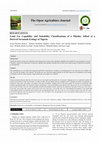
The Open Agriculture Journal
Background: In derived savanna ecology, the evaluation of soil characteristics for the current an... more Background: In derived savanna ecology, the evaluation of soil characteristics for the current and future capability and suitability for crop production is crucial. Therefore, studies were conducted to evaluate the capability and suitability of plinthic soil of a derived savannah ecology of Nigeria for sustainable crop production. Methods: The methodology was essentially Grid using hand-held GPS to determine the coordinates of sampling points for the collection of soil samples. In all, 18 profile pit samples were collected. The profile pits were described morphologically on the field using the FAO guideline on soil profile description. From the various horizons of these profile pits, soil samples were collected. Results: Land assessment indicates that the soils of the area are very fragile and inherently low in nutrients. Mapping unit A is moderately suitable for arable crop production while Units B and C are fairly suitable. For agricultural activities, mapping unit D is marginal f...
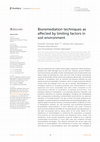
Frontiers in Soil Science, 2022
Soils are polluted by both organic and inorganic substances. Plants growing in polluted soils suf... more Soils are polluted by both organic and inorganic substances. Plants growing in polluted soils suffer damages such as leaf rolls, chlorosis, growth inhibition, root tips browning, and death of plant. Soil pollutants such as hydrocarbon and heavy metals are absorbed by crops and such ends up being consumed by human posing health risk like cancer and respiratory abnormally. Conventional methods of remediation such as chemical and physical methods are very expensive and not sustainable. Excavation, which is a type of physical method, merely shifts the pollutant from one site to another. Bioremediation is a biological method of reclaiming polluted soils. Bioremediation is less expensive and more sustainable and safer when compared to the conventional methods of reclamation of polluted environment. This biological method of remediation is an extremely attractive, important, and productive alternative for cleaning, debugging, managing, and rehabilitating and consequently ameliorating conta...
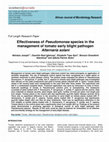
African Journal of Microbiology Research, 2017
Management of tomato early blight pathogen (Alternaria solani) has relied principally on applicat... more Management of tomato early blight pathogen (Alternaria solani) has relied principally on application of synthetic fungicides. The use of biological control agents has been recognized as a viable option to synthetic chemicals in plant disease control. The present study evaluated the effects of Pseudomonas fluorescens, P. aeruginosa, P. putida, and P. cepacia on tomato early blight pathogen and investigated their efficacy on the yield components and yield of tomato plants infected with A. solani. Tomato seeds raised in the nursery beds were transplanted to the main field after three weeks. The experiment was laid in a randomized complete block. Treatment application was done by immersion of roots of threeweek-old seedlings of tomato in Pseudomonas solution prior to transplanting. The treatments consisted of plots treated with P. fluorescens, P. aeruginosa, P. putida, P. cepacia and the control. Data were collected on disease severity, plant height, stem girth, number of fruits per plant, fruit length and fruit weight. Tomato plants in the control plot had significantly (p<0.05) higher disease severity (52.0) There was no significant difference in the severities of early blight on tomato plants treated with P. fluorescens, P. putida and P. cepacia. Tomato plants treated with P. aeruginosa had significantly (p<0.05) higher height (39.0 cm) than all other treatments. There was no significance difference in the fruit weights of tomato plants treated with P. fluorescens, P. aeruginosa, P. putida, and P. cepacia. Tomato plants in the control plots had a significantly lower fruit weight (69.5 g). Findings of the present study demonstrated a promising approach of biological control of early blight pathogen with Pseudomonas species. Results of this work could be used as bedrock for formulation of an effective and eco-friendly strategy for the management of early blight disease.
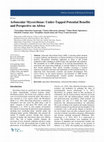
OnLine Journal of Biological Sciences, 2021
Arbuscular Mycorrhizal Fungi (AMF) is attracting global attention as organic fertilizers and alte... more Arbuscular Mycorrhizal Fungi (AMF) is attracting global attention as organic fertilizers and alternatives to chemical fertilizers in crop management practices. Mycorrhizae technology application in Africa is still juvenile compared to other continents in small-to-large scale agriculture and commerce. The sustainable use of AMF technology in in resolving bioremediation, biorestorations and conservation challenges is currently limited by the paucity of their inocula production. Their natural versatility encourages a research trajectory toward their cultivation and exploitation of their potential benefits in improving food, bioeconomic securities and product development. This review focuses on the natural dynamics and potentials of AMF beyond agriculture to biotechnologically oriented product development of industrial, environmental and food relevancies.
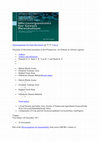
Microorganisms for Sustainability, 2017
Nutrient availability is one of the major limiting factors affecting legume production in Africa.... more Nutrient availability is one of the major limiting factors affecting legume production in Africa. With the limited arable land resources, meeting the dietary requirement of the everincreasing world population becomes a serious challenge. The most frequently deficient nutrient on crop fields is nitrogen (N). Inconvenient increase in prices of chemical nitrogen fertilizers together with the environmental problems associated with their excessive use calls for alternative low-cost and ecologically friendly soil-plant fertilization technologies. Soil microorganisms play significant roles in nutrient mineralization and supply to plant hence promoting plant growth. Soil microbes suppress soilborne plant diseases and destroy environmentally hazardous compounds in soil. Microbial inoculants are agricultural amendments that use microorganisms such as rhizobia and endophytes to promote legume growth. These microbes form symbiotic relationships with the target leguminous plant, and both parts benefit. The structure and function of the plant microbiome are major determinants of plant health and productivity. Microbial inoculants are the potential tools for sustainable agriculture.
The hydrolytic activities (cellulases and pectinases) of some arbuscular mycorrhizal fungi (AMF) ... more The hydrolytic activities (cellulases and pectinases) of some arbuscular mycorrhizal fungi (AMF) from four study sites; namely,- Malete, Bacita, Pategi and Ilorin; in southern Guinea savanna of Nigeria were studied. The DNA, RNA and protein contents of their spores were also quantified. Significant differences were observed in the hydrolytic activities of the AMF isolates. Pectinase activity of Malete AMF was F11, 22 =192.4; (p < 0.05); from

Soil Biology, 2020
Soils are the premise for agriculture and the medium in which almost all food-generating plants g... more Soils are the premise for agriculture and the medium in which almost all food-generating plants grow and as such should be kept healthy. Healthy soils produce healthy crops that in turn nourish humans and animals. Good management practices are very essential in order to maintain soil health, and one of these practices is application of biochar. Biochar provides a unique opportunity to improve soil fertility and nutrient-use efficiency using locally available and renewable materials in a sustainable way. Application of biochar to the soil leads to several interactions mainly with the soil physical, chemical and biological properties to produce a healthy soil. Due to the unique properties of biochar, which include high concentrations of organic carbon, high porosity, large surface area and presence of micropores, improvement in soil physical and hydraulic properties including soil structure, aggregation, bulk density and water holding capacity would be expected following incorporation into soils. Biochar also improves chemical soil properties by increasing soil pH, cation exchange capacity, base saturation, exchangeable bases, and organic carbon content as well as decreases Al saturation in acid soils and reduces nitrogen leaching, thereby reducing fertilizer and lime requirements and maintaining a healthy soil. Changes to both soil physical and chemical properties as a result of biochar ultimately affect the biological properties of the soil by providing microbes with a more favourable habitat. Also, because of its sustainability and affordability, biochar can be used in soil remediation.
Conventional agricultural systems such as the use of chemical fertilizers, mechanical tillage, an... more Conventional agricultural systems such as the use of chemical fertilizers, mechanical tillage, and irrigation, although increasing crop production, cause soil erosion, loss of biodiversity, and decline in soil structure and soil organic matter. However, there is a need to increase crop production to meet the increasing demands for food by the growing human population without jeopardizing soil health. The present review discusses the significance of a healthy soil and the effects of some agricultural inputs and practices on soil health. Strategies to increase agricultural food production without jeopardizing soil health are also itemized.
This work investigates the effect of rice varietal and tillage methods on the agronomic and yield... more This work investigates the effect of rice varietal and tillage methods on the agronomic and yield characteristics of ric order to quantify technology engagement and rice yield towards enhanced rice sector revolution in the nation’s Zero Hunger Developmental plan (ZHD layout involved three varieties preparation techniques (no made model DF-121) (B) and tillage with Sawah eco (Indonesian made QUICK G1000 BOXER) (C)). D stages, data collected focused on rice varietal and power tiller effect on days to asp 590 editor@iaeme.com 590–600, Article ID: IJCIET_09_13_058
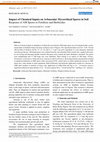
Effects of chemical inputs on abundance of arbuscular mycorrhizal (AM) fungi spores were investig... more Effects of chemical inputs on abundance of arbuscular mycorrhizal (AM) fungi spores were investigated under a maize monoculture in Southern Guinea Savanna ecological zone of Nigeria. The experimental plots received 0, 60, 120 and 180 kg N/ha of fertilizer (N.P.K. 15: 15: 15) and 0, 1, 2 and 3 kg active ingredient (a i) pre-emergence herbicide (atrazine) per hectare. AM fungal spores were isolated from the conventionally tilled, treated soils, cropped with maize by wet sieving and decanting method. Isolated AM spores were counted and spore abundance calculated. The spores were morphotyped and 13 AM fungi taxa were identified. These belong to six genera of AM fungi: Glomus, Paraglomus, Acaulospora, Enthrophospora, Gigaspora and Scutellospora. Increasing atrazine concentrations resulted in significant deduction in AMF spores while increasing N.P.K. content led to an initial significant increase in AMF spores but a later decline in spore population. Both fertilization and herbicide appl...
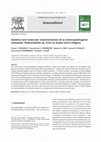
Journal of Integrative Agriculture, 2021
The occurrence of entomopathogenic nematodes (EPNs) in arable soil samples from Nigeria was inves... more The occurrence of entomopathogenic nematodes (EPNs) in arable soil samples from Nigeria was investigated using Baermann extraction tray and insect-bait (White's trap) techniques. Isolates were tested for infectivity using the larvae of Galleria mellonella (greater moth) and Tenebrio molitor (mealworm). The study revealed a new species of Heterorhabditis (MT371593) in soil samples that were randomly collected from an arable farmland cultivated to cassava TMS-30572 at the Teaching and Research Farm of Landmark University, Nigeria. Amplification of the internal transcribed spacer region (ITS) of the ribosomal DNA produced a nucleotide sequence of 933 base pairs (bp). A BLASTN search of GenBank showed that the sequence of the Nigerian isolate is identical at 99% similarity to Heterorhabditis sp. from Thailand. Infectivity test of the isolate showed 100% mortality against T. molitor larvae within 48 h of exposure while 80% mortality was recorded on G. mellonella only after 1 week of exposure. This is the first account of the Heterorhabditis sp. in Nigeria. The varying degrees of infectivity against mealworm and wax moths observed in this study proved that the Nigerian isolate of Heterorhabditis sp. could potentially be an attractive option in the management of insect pests of economic crops.
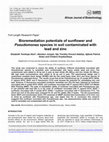
African Journal of Biotechnology, 2018
This study was conducted to assess the ability of sunflower (Tithonia diversifolia) inoculated wi... more This study was conducted to assess the ability of sunflower (Tithonia diversifolia) inoculated with Pseudomonas species to remediate soils contaminated with heavy metals (lead and zinc). The contaminants were added to 20 kg soil in pots as lead nitrate (Pb (NO 3 ) 2 ) and zinc nitrate (Zn (NO 3 ) 2 ); 400 mg/l metal concentrations were added to 20 kg soil in pots. The experimental design was a randomized complete block design (RCBD) with the two metal types (lead, zinc) and three species of Pseudomonas replicated thrice. The results reveal that all the Pseudomonas sp. (P. putida ATCC 29352, P. cepacia ATCC 29351 and P. fluorescens F113) used showed the potential for remediating zinc and lead. However, P. fluorescens inoculated sunflower remediate zinc (Zn) the best, followed by sunflower inoculated with P. putida ATCC 29352, and sunflower inoculated with P. cepacia ATCC 29351 at 8 Weeks After Planting (WAP). The order of remediation ability of sunflower inoculated with Pseudomonas spp. in soil polluted with lead (Pb) is in the order of sunflower inoculated with P. cepacia ATCC 29351 ˃ sunflower inoculated with P. putida ATCC 29352 > sunflower inoculated with P. fluorescens F113. The shoot and root of the plant were analysed for Zn and Pb uptake after 8 weeks. The bio-concentration factor (BCF) and translocation factor (TF) assessed at 8WAP showed that translocation of Zn from root to shoot by sunflower with Pseudomonas spp., was higher than Pb. In conclusion this research suggests that sunflower inoculated with Pseudomonas spp., has phytoextraction ability and could be used to remediate soil contaminated with Zn and Pb.
Frontiers in Microbiology, 2020
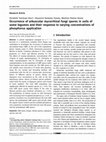
Open Agriculture
A potted experiment arranged in a 5 × 3 factorial in a randomized complete block design was under... more A potted experiment arranged in a 5 × 3 factorial in a randomized complete block design was undertaken to investigate the occurrence of arbuscular mycorrhizal fungi (AMF) in the soil of five leguminous plants: Cajanus cajan (L.) Huth, Centrosema pascuorum Martius ex Benth, Crotalaria ochroleuca G. Don, Lablab purpureus (L.) Sweet and Mucuna pruriens (L.) DC. The effects of varying phosphorus concentrations (P0) (0 kg/ha of single superphosphate), P1 (100 kg/ha of single superphosphate) and P2 (200 kg/ha of single superphosphate) on the population of AMF spores under these legumes were also carried out. The AMF spores in soil samples were extracted at 19 weeks after planting, using the wet sieving and decanting method, and enumerated with the aid of a stereoscopic microscope. Spores of different species of genera Glomus and Gigaspora were encountered in the soils of the five leguminous plants. Spores of Glomus species predominated while the spores of Gigaspora species were found in l...
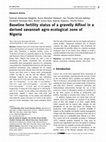
Open Agriculture
Farmers have not tested their soils for nutrient status and therefore are unaware of the fertilit... more Farmers have not tested their soils for nutrient status and therefore are unaware of the fertility status of their soils. Therefore, a baseline fertility survey of 50 hectares of land of a gravelly Alfisol in the Teaching and Research Farm of Landmark University, Omu-Aran, Kwara State, Nigeria was carried out with a view to identifying soil health constraints and site-specific sustainable land management practices for optimizing crop production. Standard field protocols and laboratory analytical procedures were employed for all sample parameters measured. Results show that the soil textural classes vary from sand to loamy sand, exchangeable acidity, Ca, Mg, K, and Na and the effective cation exchange capacity has the surface and subsurface soil values of 0.0–0.92 and 0.00–0.89 cmol kg−1, 1.6–7.7 and 2.0–5.8 cmol kg−1, 1.2–11.5 and 0.7–8.0 cmol kg−1, 0.09–0.33 and 0.09–0.43 cmol kg−1, 0.0–0.16 and 0.04–0.16 cmol kg−1, 7.2–12.10 and 0.9–12.5 cmol kg−1, respectively. P values lie in th...
World Journal of Microbiology and Biotechnology
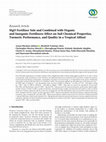
The Scientific World Journal
For soil fertility maintenance, secondary nutrient such as Magnesium (Mg) is always being neglect... more For soil fertility maintenance, secondary nutrient such as Magnesium (Mg) is always being neglected. However, its role is critical in the growth, yield, and quality of crops. Therefore, two field experiments were initiated in 2017 and 2018 to evaluate the response of soil chemical properties, performance, and qualities of turmeric (Curcuma longa L.) to Mg fertilizer alone and in combination with poultry manure (PM) and NPK 15-15-15 fertilizer (NPK). The treatments applied were the following: (i) PM alone at 8 t ha−1, (ii) NPK alone at 200 kg ha−1, (iii) Mg fertilizer alone (in form of MgO) at 20 kg ha−1, (iv) PM at 8 t ha−1 with MgO at 20 kg ha−1 (PM + Mg), (v) NPK at 200 kg ha−1 with MgO at 20kgha−1 (NPK + Mg), and (vi) control (no amendment of any kind). PM, NPK, and Mg fertilizers alone or NPK + Mg and PM + Mg increased soil chemical properties, performance (plant height, number of leaves, number of tillers, number of rhizomes, and fresh rhizome weight), and minerals and vitamins...


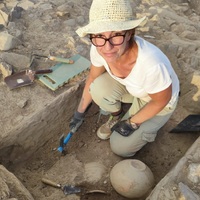








Uploads
Papers by ELIZABETH ALORI